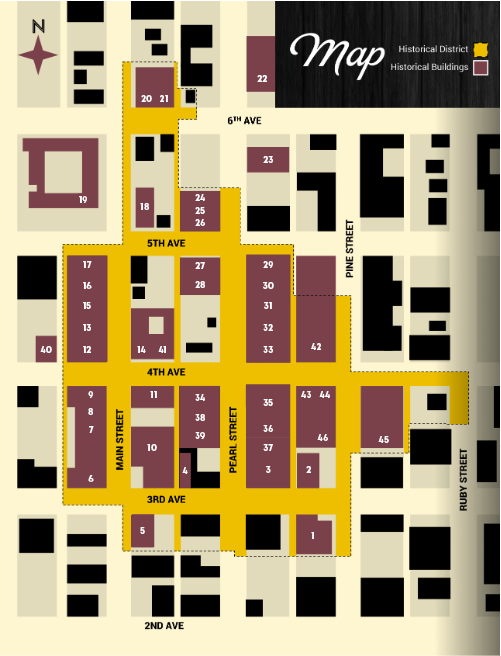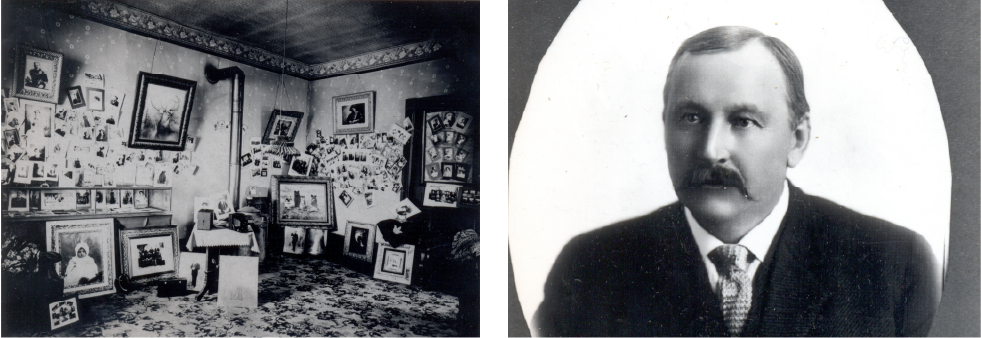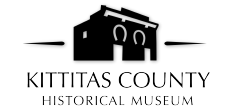Walkabout Guide
Welcome to our interactive Walkabout Guide! To find out more information about each of these historical locations in Ellensburg, please click on one of the numbered areas on the map below!
For a downloadable version of the map above, click the button below! We also invite you to get a physical copy by stopping by the Kittitas County Historical Museum at 114 E. 3rd Avenue, Ellensburg, WA 98926 Monday – Saturday: 10AM – 4PM.
1. Cadwell Building 1889
J.C. Lloyd and Edward P. Cadwell originally contracted the construction of this unique building along with an adjacent building. In early 1890, Cadwell became the sole owner of the building, which was built to house two retail spaces on the first floor and offices on the second. It was used by a variety of businesses until the Kittitas County Historical Society purchased the building in 1974 and restored the storefronts between 1978 and 1982.

1. Cadwell Building: 1889
J.C. Lloyd and Edward P. Cadwell originally contracted the construction of this unique building along with an adjacent building. In early 1890, Cadwell became the sole owner of the building, which was built to house two retail spaces on the first floor and offices on the second. It was used by a variety of businesses until the Kittitas County Historical Society purchased the building in 1974 and restored the storefronts between 1978 and 1982.
2. Fogarty Building: 1889
Originally constructed by John B. Fogarty, this building was completed in two phases, with the western half (now former theater) in October 1889 and the eastern half by 1893. The theater was one of the earliest in the area, opening around 1915 as the Colonial. In the 1920s, it was remodeled into the Art Deco style and renamed the Audion Theatre.
3. Kreidel Building: 1889
This building, originally owned by Samuel Kreidel, was the largest building built in downtown Ellensburg. It towered over nearby buildings, a landmark to those arriving on the railroad, with its onion shaped cupola. Those elements were removed during remodel in the late 1920s.
4. S.R.G. Building: 1889
Built by Sylvanus R. Geddis, the architecture of this petite building disguises its actual size. This building was one of the few to have survived for over a century in original condition. It was modeled after the nearby Geddis Block, using many of the same features in its design, and has held a number of brewery and winery businesses.
5. Edison Hotel Building: 1911
Also known as the Giovanini Building, it was built by upper Kittitas County resident, Peter Giovanini, and was home to the New York Café, a Chinese restaurant, for many decades. The second floor originally featured 27 rooms off of five skylight-lit corridors. This building was one of three concrete buildings in Ellensburg.
6. Shoudy-Cadwell Block: 1889
John A. Shoudy and Edward P. Cadwell partnered to have this building built with several retail storefronts and a hotel upstairs. The hotel was used by many individuals both for short and long term stays before closing in the late 1960s. The hotel also included rooms in the Localizer Building.
7. Localizer Building: 1889
Built to house one of the five newspapers in Ellensburg, the Localizer Building took its design from the neighboring ShoudyCadwell Block, including housing rooms for the upstairs hotel. The Localizer newspaper was operated by David J. Schnebly between 1889 and 1909 before being purchased by William S. Zimmerman and J. C. “Cliff” Kaynor who renamed the newspaper as the Evening (now Daily) Record and moved location.
8. Geiger Woods Building: 1889
John Geiger and Alfred Woods partnered to construct this building with each taking a storefront for their respective businesses as a tailor and a barber. The second floor was occupied by a hotel. There was more ornamentation and tinwork than the neighboring buildings while its cast iron columns came from Chicago. Half of the building still retains its original storefront.
9. Pearson Building: 1908
Samuel Pearson had this building built in 1908, incorporating similar design elements from nearby buildings. Cast iron columns decorate the main storefronts, while traditional brickwork and corbelling decorate the overall building. It has housed a variety of businesses, including the Bazaar (an early department store), and organizations like the Elks fraternal lodge.
10. Arcade Building: 1908
This building has unique arched windows that once included electric lights along the arch. The building got its name from the fun nature of the businesses that were once there, including a saloon that had the longest bar in Kittitas County, an amusement arcade full of mutoscopes (an early motion picture device) and the second floor boasted a large public hall for local dances and meetings. Other businesses included a bank, a meat locker, and Ellensburg’s first bicycle shop.
11. Fitterer Brothers Building: 1908
In 1896, Fitterer Brothers Furniture Company was founded by Philip and Frank Fitterer. They commissioned a building which was completed for them in September 1908, where the business has remained for multiple generations. The second and third floors of the building were damaged by fire when the neighboring Blumauer-Webb Building burned in 1986.
12. Daily Record Building: 1910
This building, made from terracotta block and currently refaced with brick, is similar to the neighboring Fitterer Brothers Building by having only been one owner and occupant from its construction. The Daily Record Building was built to house the offices and printing equipment of the Ellensburg Evening Record, which was owned by J. C. “Cliff” Kaynor and William S. Zimmerman.
13. Nicholson Auto Building: 1915
This building has been primarily used as a garage and auto dealership since its construction. The first business was Nicholson Auto and Machine Works, owned and operated by Charles, Clarence, and Thomas Nicholson. Emery H. Mahan later used the building for Mahan Motors auto dealership in the early 1930s. The building is also known as the Heinrich Building due to the longtime use by the Heinrich Auto Electric Shop, owned by Frank “Heinie” Heinrich.
14. Castle Building: 1889
Orin B. Castle constructed this building for his saloon business, the Keghouse, which sold fine liquors and cigars. The exterior, which was soft Ellensburg brick was covered with a concrete-plaster coating in the 1910s. After Prohibition and the ban of alcohol sales, the building was used for general businesses, clothing stores, and harness and saddlery stores. The building was restored in the early 2010s.
15. B. F. Reed Building: 1910
Briggs F. Reed constructed this Spanish-Colonial building for use as a garage. It was first occupied by Herbert Wight who repaired, painted, and sold carriages and automobiles. The Ellensburg Automobile Company (later Kelleher Motor Company) first offered its business there, where it offered full service and sales. While the concrete structure has been used primarily for automobiles, it has since been remodeled into multiple business spaces and retains its arched windows and garage-door openings.
16. Busby Blacksmith Shop: 1912
Alvin C. Busby had this building built to house his blacksmithing business which provided general blacksmithing, horseshoeing, and installation of rims on buggy wheels. He continued to do farm repairs along with manufacturing automatic coal stokers. In 1975, the business relocated out of Ellensburg and the building has since had been used for retail and business offices.
17. Bledsoe Tire & Motor Co. Building: 1922
Owned by Howard F. Bledsoe, this building was built to house an automotive and tractor dealership and repair company. This business only occupied the building for a short time before Lindeman Power Equipment Co. and a variety of car dealerships. It became most known for Butterfield Chevrolet, owned by Harry Butterfield and later son Robert Butterfield who purchased it in 1957. The building is now used by a variety of businesses.
18. Elks Temple Building: 1923
The Benevolent Protective Order of the Elks (BPOE) built this building in 1923, after having used a variety of locations in Ellensburg, including the Pearson Building. The building was the first steel-constructed building in downtown Ellensburg, and Charles I. Carpenter, an architect from Spokane, designed this building along with many other buildings for fraternal groups in Washington and Idaho. The Elks closed the temple in the mid-2000s, and the building was renovated in the mid-2010s.
19. Kittitas County Courthouse: 1958
In 1958, the second Kittitas County Courthouse was completed and opened as the government offices of Kittitas County. The location was home to the original Kittitas County Courthouse, which was built in 1886, three years after the county split from Yakima County and was incorporated.
20. Camozzy & Williams One-Stop Station: 1929
Ernest W. Ames built this station for Milton Camozzy and George Williams to house a tire repair shop and tire department, gas pumps, washing and greasing racks, and a wheel and rim department which opened on July 15, 1929. Much of the construction was locally sourced with companies including the Tum-A-Lum Lumber Co., the Ellensburg Lumber Co., the Modern Plumbing Co., and the Puget Sound Power & Light Co. The building has been home to a variety of businesses including a market and more recently a restaurant.
21. Masonic Temple: 1890
The Ellensburg Masonic Temple was built in early 1890 when the organization relocated from their destroyed building at 4th and Pine. The building was built using three types of terracotta and locally-made tinwork and cast iron columns. While the second floor has always been home to the meeting rooms of the Temple, the first floor has had a number of businesses including funeral parlors and the first telephone company offices in Ellensburg.
22. Kelleher Motor Company: 1927/1986
Originally a bicycle dealership, Kelleher Motor Company is the oldest automobile dealership in Kittitas County. The business was founded in 1911 by Jack Kelleher and still remains owned and operated by the Kelleher Family. By 1930, the motor company moved to the current location of Sixth Avenue and Pearl Street where they had a service station across the street from the showroom and repair shop. In 1985, the original showroom and repair shop was lost to fire, but the company rebuilt to what is seen today .
23. Shaw’s Appliance & Furniture Building: 1919
In 1919, the W L Eaton Company became the first business in the newly constructed building. While headquartered in Seattle, the car dealership sold Dodge cars, Republic trucks, tires, and accessories at this location. In 1946, Fred and Maxine Shaw opened the “Electric Supply” store, which was taken over by son, Steve, and his wife, Phyllis in 1980. It was then transitioned to Shaw's Furniture and Appliance, and is still operated by members of the Shaw family today.
24. Reynolds Garage Building: 1914
Alfred Reynolds had this building constructed for the Reynolds Motor Car Co., which sold Studebaker vehicles and housed them for owners without private garages. Like many other dealerships in downtown Ellensburg, the location also had a gas pump on the sidewalk. The b u i l d i n g w a s h o m e t o o t h e r c a r dealerships, an early television cable service, and an appliance store.
25. Zwicker Building: 1912
This light-colored brick building was built by Barthel Zwicker as an investment property. The first business on the first floor was H. F. Bledsoe’s Grocery Store. Later businesses included state and federal offices, a barber shop, and real estate offices, while the second floor has been used as office space and apartments. A later remodel included more art deco styling with small-paned glass in the transom windows along the storefront, in the panel of the doorway to the first floor businesses, and one above the second floor entry.
26. Farmers Bank Building: 1911
In 1911, the Farmers Bank Board of Directors contracted F. R. Spangler, a local architect, to design and build this neo-classical bank structure from Tenino Quarry sandstone. The bank merged with National Bank of Commerce, who later outgrew the structure and moved across the street. In 1967, Kittitas Land Title Company purchased and remodeled the building for its land title offices.
27. Lynch Block: 1888
Also known as the “1888 Building,” this structure was built by Pat Lynch. It was completed and opened with a grand ceremony and event on January 10, 1889. The building was one of several that survive the Great Ellensburg Fire of July 4, 1889 and is the only one still standing. In the 1920s, architectural ornaments were removed from the building like onion-shaped finials and its triangular tin motif. The building was restored in the 1980s.
28. Dickson Building: 1919
Elizabeth Dickson contracted William O. Ames to build the terracotta block building which was completed on May 22, 1919. The first occupants were C. E. Wheeler and Co., a mercantile, and J. N. O. Thompson, a jeweler. While used by a number of other businesses, one of the most memorable occupants was Dean’s Radio and Television.
29. National Bank of Ellensburg: 1888/1930
Known as the Brick Bank, the original structure was built in 1888 by Edward P. Cadwell and then owned by the National Bank of Ellensburg under the management of Austin Mires, the first mayor of Ellensburg. In 1906, it was purchased by Farmer’s Bank which then relocated in 1911 to the new building across the street. The building was then purchased by Julius C. Hubbell who owned the building until selling it to Clarence S. Darrow in the late 1920s. In November 1930, the building reopened after undergoing a major remodel into the art deco form designed by Charles Gould. In 1937, the building was sold to the City of Ellensburg and used as city hall until 2004.
30. Ramsay Building: 1901
Richard and James Ramsay had this building constructed to house the Ramsay Hardware Company, which remained in business until 1962. The second floor previously housed medical and professional offices in addition to a large multi-purpose room. The building still boasts its original storefronts but elements like its locally-made cast iron columns were removed after the Ramsay Hardware Company closed.
31. Wilson Building: 1889
Thomas Wilson arranged for the building’s construction to house his dry goods business. The building was made using locally-produced bricks and cast iron columns. Along the top and on window hoods, tinwork was used similar to the nearby Davidson Building. On the north end of the building is an edge of tinwork that signified the original end of the block. Businesses located in the Wilson Building included dry goods, a variety store, printing services, and a pet store.
32. Stewart Building: 1889
Initially known as the Davidson-McFall block, the Stewart Building was commissioned by the law office of Judge John B. Davidson and D. H. McFall, designed by J. B. Randall, and built by William O. Ames. It was completed by December 1889, and many of the second floor offices were filled with professional services, while various businesses used the first floor. The building was highly ornamented, similar to the neighboring Davidson Building, and included cast iron columns from an unknown foundry and small pane stained-glass transom windows along both floors. Charles H. Stewart operated a real estate office out of the location, while in the 1940s and 50s, his son Glenn R. Stewart had an insurance office there. In 1968, the building became home to the Ellensburg Community Art Gallery and underwent a series of remodels.
33. Davidson Building: 1889
This well-known landmark structure of Ellensburg was built by Judge John B. Davidson. Cast iron from Chicago decorated the storefronts while local tinwork mimicked stone on the columns, along the top, and on the tower. On the Fourth Street side of the building, a finial shaped as a phoenix graced the parapet, symbolizing Ellensburg’s rise from the ashes of the Great Fire of 1889. The Davidson Building was restored between 1979 and 1982.
34. Geddis Building: 1889
By 1888, Sylvanus R. Geddis had constructed the first brick building in Ellensburg. While it was lost to the Great Fire of 1889, Geddis quickly rebuilt it with iron columns from Chicago and locally-made decorative cresting along the parapet. In 1964, the decorative elements were covered with corrugated aluminum siding or removed entirely. The aluminum siding was removed in the 1980s, while the entire building underwent restoration in the mid-2010s. The first floor has been home to a variety of businesses, while the second floor has been used as a hotel and apartments.
35. Ben Snipes Bank & Co. Building: 1889
The Ben E. Snipes Bank & Co. Building was built from Kittitas County sandstone in 1888 and soon destroyed by the Great Fire of 1889. Snipes rebuilt using the same sandstone and cast-iron from Chicago, but added more storefronts and a second floor to the bank. Due to the Panic of 1893, the bank closed, and the building was sold at the sheriff’s auction. The stonework was covered in the 1950s with a new, modern exterior. The location has always been home to a bank.
36. Pautzke Building: 1905
The Pautzke Building was originally constructed in early 1905 by Henry Rehmke, a jeweler who owned the Rehmke Building that today houses the Tav. He had decided to build a one-story building that would be 30-feet by 70-feet and divided into two rooms. The first tenant of the new building was Otto W. Pautzke who set up his Art Studio in the space, where it would be located for over 40 years. Pautzke Studios was known for their quality of photographs, documenting and memorializing individuals and families, buildings and businesses, and almost every special occasion for citizens in Kittitas County and throughout the Central Washington region. Their photos were featured everywhere from family cabinets and albums to worldwide magazines and newspapers. After Pautzke Studios later sold and became Boehner Studios and closed, the building became home to a number of stores, nonprofit organizations, barbershops, and more. Today, the building is owned by the Kittitas County Chamber of Commerce who has taken efforts to recognize the building history and its most noted tenant by putting the history of the building back on view, with the installation of the “Pautzke Building” signage.

37. Smithson Building: 1889/1906
John H. Smithson arranged for William O. Ames, a local builder, to help with both the design and construction of this building. The Williams-Smithson Hardware Co. occupied the site for many years, first occupying a single storefront to the south of the current building. In 1906, the building was extended to its current size, adding two additional storefronts. The building has been consistently home to a hardware store along with a variety of businesses including agricultural implements, a grocery store and bakery, and a wagon dealer. The second floor offices were once used for medical and professional services.
38. Bossong Building: 1889
Frank Bossong built this structure to house his bakery, F. Bossong and Co., which opened the doors in November 1889, after losing the original building in the Great Fire. Over time, the building, and business became known as Boss Bakery and remained the same despite changing ownership. The building’s storefront was fully remodeled in 1913. The bakery closed in the 1940s, and the building has been used for a variety of businesses since including a sporting goods store, jewelry store, and more recently an art gallery.
39. Kleinberg Building: 1889
Henry and Samuel Kleinberg constructed the three-story building with terracotta from San Francisco and cast iron from Chicago. The building was originally planned to have two storefronts, but with limited finances, the building was not fully completed with the southern storefront left at one floor. The Kleinberg Brothers opened their clothing store in January 1890, and over time, several other businesses used the building. The second floor was home to a hotel and, on the third floor, a Jewish meeting hall. On December 14, 1935, the southern half of the building caught fire when the boiler exploded and the fire fanned to the second and third floors. Afterward, those floors became inaccessible. In the mid-2010s, the building underwent a full restoration, allowing access to the new apartments.
40. Alrich Auto Garage: 1910
William Taylor contracted Marshall A. Dean to build a new brick garage for Aldrich Auto Co. which had outgrown its nearby location. Soon after, the building and business were purchased by Alfred Reynolds, who occupied the location until 1914. Many businesses have used the various storefronts including veterinarians, machinists, agricultural implement dealers, cabinetmakers, and restaurants.
41. Rehmke Building: 1889
William and Henry Rehmke had this building commissioned to house their business, The Remhke and Brother Jewelry Store, which sold fine jewelry, clocks, china, and more. On November 1, 1899, the business was robbed, but the stolen items were all recovered, leading to more security measures being added. In June 1951, a fire broke out in the second floor apartments, leaving behind a charred framework of timbers over the nearly undamaged first floor. The second floor was razed, which left the building housing only the bar and restaurant.
42. Elmira Block: 1889
W. W. Fish had this building constructed, which was the first brick building completed after the Great Fire. Fish named the building for his hometown of Elmira, New York, and had it designed in the High Victorian style. It originally featured handsome arched windows, a massive cornice, and pediment. The second floor has been home to the Elmira, the Vanderbilt, and the Vale Hotels, before being closed in the late 1960s. The first floor has been occupied by a variety of businesses including the New York Store, a meat market, a sporting goods store, and a bakery.
43. Fish Block: 1889
Also known as the Bath Block, this building was built for W. W. Fish in the High Victorian style. Over time, many businesses occupied the space including a soda fountain, a hotel, and one of the local newspapers, the Ellensburgh Capital, occupied the space for more than 25 years. The building was remodeled into the Art Deco style in 1931 by John Satterwhite, owner, and Fulton Construction Co., contractor, to house MacMarr’s grocery store. The storefront was recessed in the 1990s to accommodate a clothing store.
44. Collins Block: 1910
Charles L. Collins had this building built in 1910 to house his clothing store. In 1931, the building was remodeled both interiorly and exteriorly by the Fulton Construction Co. to house the J. C. Penney’s store. While being home to a number of businesses, the Collins Block has had a few of Ellensburg’s favorites including Ostrander Drug Co. and Moser’s Clothing Store.
45. Craig Building: 1889
Benjamin F. Craig had this building designed with the intention of having a grand city hall. As it was being built, the funding was reduced, and he settled with a smaller building than expected by not including the planned third floor. Craig intended to sell the building to the City of Ellensburg, and while the sale might not have occurred, the building was used by the City of Ellensburg as its official offices until the 1930s. The southern portion of the building was used by the Ellensburg Fire Department to house the horses and horse-drawn fire equipment.
46. I.O.O.F. Lodge Building: 1889/1913
The Independent Order of Odd Fellows (IOOF) Lodge was founded in Ellensburg in 1881. After losing the original building on the corner of Third and Pearl to the Great Fire, the IOOF rented space in the Maxey Building on Pine Street, which had been built in late 1889. In 1901, the Lodge finally raised enough money to purchase this site in the Maxey Block and expanded the building. The construction was completed in 1913 and the Lodge has been in residence ever since.
Work In Progress
Be on the lookout for the addition of historical photographs, archival materials, stories and other anecdotes as we dive deeper into our files to find out even more about what’s hiding behind each building’s beautiful façade. Information is being located, photographed, and digitized through the generous help of our volunteers. To consider becoming a volunteer and helping out with the project and others, click below!
A Brief History Of Ellensburg
Ellensburg was established in 1875 by John and Mary Ellen Shoudy with the original core of downtown Ellensburg being First Avenue to Sixth Avenue, Water Street to Ruby Street. The town quickly grew as people and businesses moved to the area. With the Northern Pacific Railroad entering the area in 1885, it enabled the community to grow even quicker.
On July 4, 1889, the young community of Ellensburg burned to the ground. While no lives were lost, property damage amounted to over $2 million (or valued at $50 million in 2017). Ten downtown city blocks and the homes of 200 were lost in an inferno that only took 4 hours to consume the community.
Within weeks of the fire, those in the community began to rebuild. Local timber, iron, and brick were used in the construction. Many building owners came together to purchase tinwork and other building elements from locations like Chicago and San Francisco. It only took 4 months to rebuild downtown Ellensburg. Most of the buildings were either built in late 1889 or during a second building phase between 1908 and 1912.
Many of the early building owners lost their investments and properties in the Panic of 1893, a financial depression that rocked the United States causing many banks to fail. New buyers acquired the buildings at a fraction of the original cost, and often held onto these properties for generations. While as financially severe, the Great Depression did not have as bad of an impact locally.
The following is a self-guided walking tour of the historic buildings in Downtown Ellensburg. The Kittitas County Historical Museum offers guided walking tours and more comprehensive information on the historic buildings.
Please note, since some information is still elusive and incomplete, some buildings may be omitted in this walking tour map or listed as still yet to be compiled.




